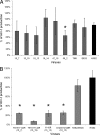Secondary integrase resistance mutations found in HIV-1 minority quasispecies in integrase therapy-naive patients have little or no effect on susceptibility to integrase inhibitors
- PMID: 20479206
- PMCID: PMC2935022
- DOI: 10.1128/AAC.01720-09
Secondary integrase resistance mutations found in HIV-1 minority quasispecies in integrase therapy-naive patients have little or no effect on susceptibility to integrase inhibitors
Abstract
The goal of this study was to explore the presence of integrase strand transfer inhibitor (InSTI) resistance mutations in HIV-1 quasispecies present in InSTI-naïve patients and to evaluate their in vitro effects on phenotypic susceptibility to InSTIs and their replication capacities. The RT-RNase H-IN region was PCR amplified from plasma viral RNA obtained from 49 HIV-1 subtype B-infected patients (21 drug naïve and 28 failing highly active antiretroviral therapy [HAART] not containing InSTIs) and recombined with an HXB2-based backbone with RT and IN deleted. Recombinant viruses were tested against raltegravir and elvitegravir and for replication capacity. Three-hundred forty-four recombinant viruses from 49 patients were successfully analyzed both phenotypically and genotypically. The majority of clones were not phenotypically resistant to InSTIs: 0/344 clones showed raltegravir resistance, and only 3 (0.87%) showed low-level elvitegravir resistance. No primary resistance mutations for raltegravir and elvitegravir were found as major or minor species. The majority of secondary mutations were also absent or rarely present. Secondary mutations, such as T97A and G140S, found rarely and only as minority quasispecies, were present in the elvitegravir-resistant clones. A novel mutation, E92G, although rarely found in minority quasispecies, showed elvitegravir resistance. Preexisting genotypic and phenotypic raltegravir resistance was extremely rare in InSTI-naïve patients and confined to only a restricted minority of secondary variants. Overall, these results, together with others based on population and ultradeep sequencing, suggest that at this point IN genotyping in all patients before raltegravir treatment may not be cost-effective and should not be recommended until evidence of transmitted drug resistance to InSTIs or the clinical relevance of IN minor variants/polymorphisms is determined.
Figures



Similar articles
-
Impact of combinations of clinically observed HIV integrase mutations on phenotypic resistance to integrase strand transfer inhibitors (INSTIs): a molecular study.J Antimicrob Chemother. 2022 Mar 31;77(4):979-988. doi: 10.1093/jac/dkab498. J Antimicrob Chemother. 2022. PMID: 35061879
-
Prevalence of primary resistance mutations to integrase inhibitors in treatment-naïve and -experienced patients infected with B and non-B HIV-1 variants.HIV Clin Trials. 2013 Jan-Feb;14(1):10-6. doi: 10.1310/hct1401-10. HIV Clin Trials. 2013. PMID: 23372110
-
Lack of impact of pre-existing T97A HIV-1 integrase mutation on integrase strand transfer inhibitor resistance and treatment outcome.PLoS One. 2017 Feb 17;12(2):e0172206. doi: 10.1371/journal.pone.0172206. eCollection 2017. PLoS One. 2017. PMID: 28212411 Free PMC article.
-
Characterization and structural analysis of HIV-1 integrase conservation.AIDS Rev. 2009 Jan-Mar;11(1):17-29. AIDS Rev. 2009. PMID: 19290031 Review.
-
A clinical review of HIV integrase strand transfer inhibitors (INSTIs) for the prevention and treatment of HIV-1 infection.Retrovirology. 2022 Oct 22;19(1):22. doi: 10.1186/s12977-022-00608-1. Retrovirology. 2022. PMID: 36273165 Free PMC article. Review.
Cited by
-
Impact of primary elvitegravir resistance-associated mutations in HIV-1 integrase on drug susceptibility and viral replication fitness.Antimicrob Agents Chemother. 2013 Jun;57(6):2654-63. doi: 10.1128/AAC.02568-12. Epub 2013 Mar 25. Antimicrob Agents Chemother. 2013. PMID: 23529738 Free PMC article.
-
Study of genotypic and phenotypic HIV-1 dynamics of integrase mutations during raltegravir treatment: a refined analysis by ultra-deep 454 pyrosequencing.J Infect Dis. 2012 Feb 15;205(4):557-67. doi: 10.1093/infdis/jir821. Epub 2012 Jan 11. J Infect Dis. 2012. PMID: 22238474 Free PMC article.
-
Clinical implications of HIV-1 minority variants.Clin Infect Dis. 2013 Jun;56(11):1667-74. doi: 10.1093/cid/cit125. Epub 2013 Feb 27. Clin Infect Dis. 2013. PMID: 23446628 Free PMC article.
-
HIV-1 integrase resistance among antiretroviral treatment naive and experienced patients from Northwestern Poland.BMC Infect Dis. 2012 Dec 21;12:368. doi: 10.1186/1471-2334-12-368. BMC Infect Dis. 2012. PMID: 23259737 Free PMC article.
-
G140S/Q148R and N155H mutations render HIV-2 Integrase resistant to raltegravir whereas Y143C does not.Retrovirology. 2011 Aug 19;8:68. doi: 10.1186/1742-4690-8-68. Retrovirology. 2011. PMID: 21854605 Free PMC article.
References
-
- Baldanti, F., S. Paolucci, R. Gulminetti, M. Brandolini, G. Barbarini, and R. Maserati. 2010. Early emergence of raltegravir resistance mutations in patients receiving HAART salvage regimens. J. Med. Virol. 82:116-122. - PubMed
-
- Buzón, M. J., S. Marfil, M. C. Puertas, E. Garcia, B. Clotet, L. Ruiz, J. Blanco, J. Martinez-Picado, and C. Cabrera. 2008. Raltegravir susceptibility and fitness progression of HIV type-1 integrase in patients on long-term antiretroviral therapy. Antivir. Ther. 13:881-893. - PubMed
-
- Canducci, F., M. Sampaolo, M. C. Marinozzi, E. Boeri, V. Spagnuolo, A. Galli, A. Castagna, A. Lazzarin, M. Clementi, and N. Gianotti. 2009. Dynamic patterns of human immunodeficiency virus type 1 integrase gene evolution in patients failing raltegravir-based salvage therapies. AIDS 23:455-460. - PubMed
-
- Ceccherini-Silberstein, F., D. Armenia, R. D'Arrigo, V. Micheli, L. Fabeni, P. Meraviglia, A. Capetti, M. Zaccarelli P. Trotta, P. Narciso, A. Antinori, and C. F. Perno. 2008. Virological response and resistance in multi-experienced patients treated with raltegravir. Antivir. Ther. 13(Suppl. 3):A20.
-
- Ceccherini-Silberstein, F., D. Armenia, R. D'Arrigo, I. Vandenbroucke, L. Fabeni, K. Van Baelen, H. Van Marck, V. Micheli, S. Lo Caputo, V. Tozzi, A. Capetti, P. Narciso, L. Stuyver, G. Rizzardini, A. Antinori, and C. F. Perno. 2009. Baseline variability of HIV-1 integrase in multiexperienced patients treated with raltegravir: a refined analysis by pyrosequencing, abstract 682. Sixteenth Conference on Retroviruses and Opportunistic Infections, Montreal, CA. http://www.retroconference.org/2009/Abstracts/35747.htm.
Publication types
MeSH terms
Substances
LinkOut - more resources
Full Text Sources

